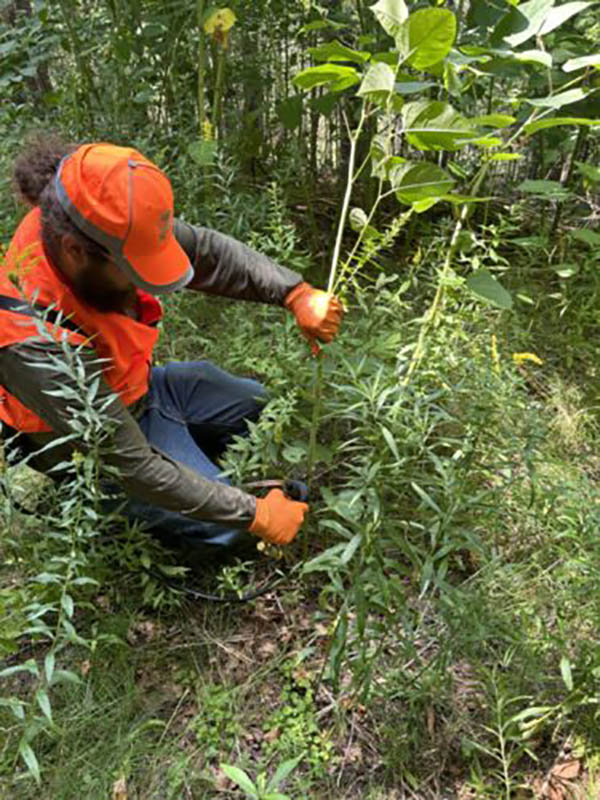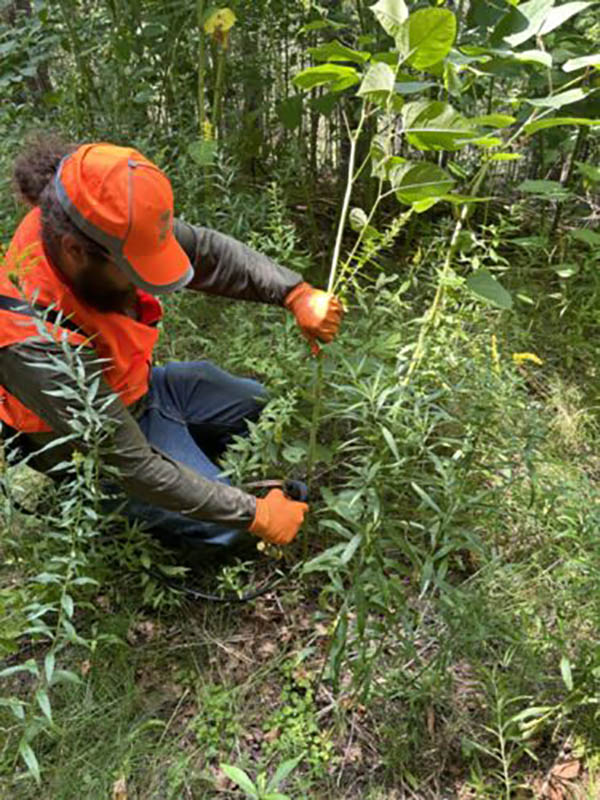
Adirondack Research Field Technician Gage Root injects herbicide into a Japanese Knotweed plant’s stem during the 2024 treatment season.
(Provided photo — Justin Wolford)
To the editor:
Think back to 2008 when Japanese knotweed was widespread through Inlet, Old Forge, Blue Mountain Lake and many other areas and roadways in the Adirondacks. Since then, knotweed has been eradicated at hundreds of sites and is markedly less at others across the Adirondacks. In contrast, knotweed has expanded throughout much of the Northeast.
Yet, the Adirondacks still have numerous sites with knotweed that have never been treated and others with relatively few plants where there had been hundreds to thousands. If knotweed is not eradicated at a site, it will spread anew, so eradication at each site is the goal.
The Regional Inlet Invasive Plant Program began efforts in 2008 to control knotweed throughout the Adirondacks, including on private property at no cost to landowners, relying on donations and a few years of grant funding. The program has also treated some sites with wild parsnip and phragmites.
Initially, the town of Inlet, then the Hamilton County Soil and Water Conservation District, helped administer the program with many volunteers helping identify sites and obtaining property owner permissions.
In 2020, Adirondack Park Invasive Plant Program took over RIIPP’s efforts to control knotweed. In 2023, APIPP decided to no longer treat knotweed on private property, putting the program at risk of ending. Fortunately, in 2024, Adirondack Research began administering these efforts with their Invasive Species Management Initiative. ISMI is funded from donations to the Saranac Lake Rotary Foundation eradication of invasive terrestrial plants fund.
In 2024, ISMI treated over 60 sites with knotweed. ISMI expects to treat over 140 sites in 2025 through more of the Adirondacks, but more donations are needed.
Treatment includes stem injection of herbicide and foliar spray to plants too small to inject by certified pesticide applicators, which needs to be done in August or September when the plant is taking nutrients to its rhizome (root) system.
Those interested in knotweed control in the Adirondacks are encouraged to donate to the Rotary Foundation fund, learn more about the ISMI program, and give permission to have knotweed treated on their property using Adirondack Research’s website (adkres.org/ismi/). Further information about RIIPP and efforts to control knotweed in the Adirondacks can be found at www.noknotweed.org.
Douglas Johnson
Inlet
To the editor:
Thanks to Aaron Marbone for the excellent write up on wolves (“The Way of the Wolf,” Aug. …
To the editor:
What if…
General George Washington had decided the fight was too hard and the odds were too …
To the editor:
Now here we are passing the halfway point in another summer. For me it’s a 70th summer. Never …
To the editor:
I am writing to thank the Enterprise for printing our letters to the editor over so many years. …
To the editor:
Preventing cancer or finding it early is a priority in New York state because cancer is the …


AloJapan.com